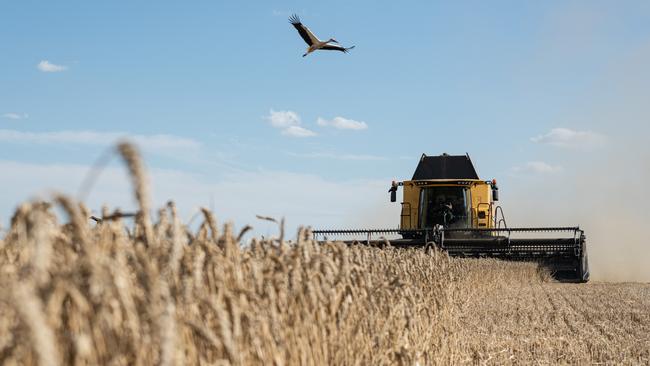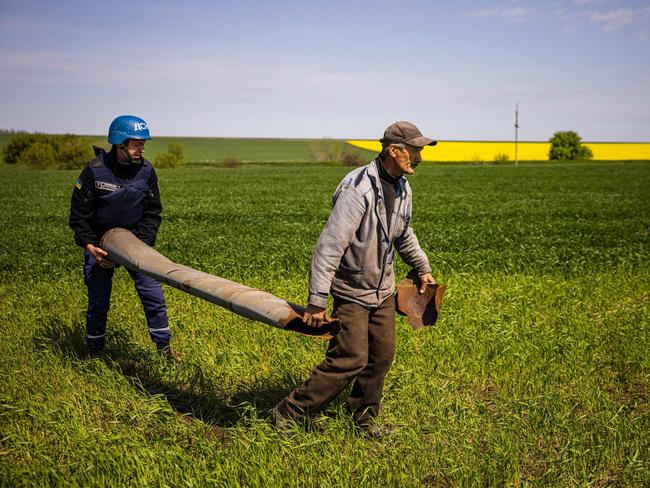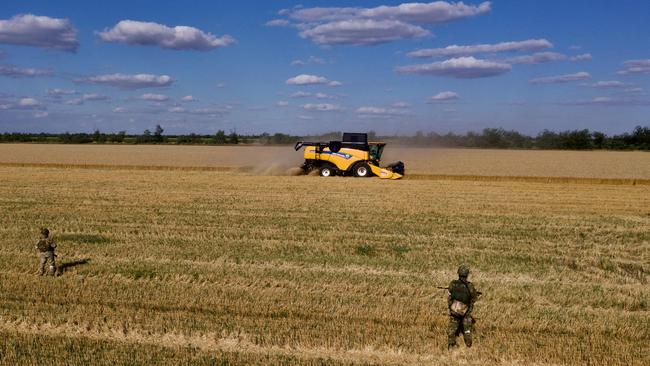Ukraine’s farmers being a wheat harvest like no other
They brave mines and grapple with damaged equipment, but their resilience masks problems likely to last long after the war ends.

Misha Ananenko was on a tractor near this Ukrainian village when a mine underneath him exploded, erupting the earth around him. He picked himself up, showered, had a shot of vodka and the next day went back to work. “Farming is always a struggle,” he said.
But as Mr Ananenko and other farmers start their first wheat harvest since Russia invaded Ukraine, their resilience masks big problems for the country’s globally important agriculture industry that are expected to last long after the guns fall silent.
This harvest will be an early test of how Ukrainian farming is faring. Early readings suggest low yields owing to overly warm weather and a lack of fertiliser. A poor harvest would compound problems for the many farmers who have been unable to sell all their crops and are already struggling to finance the next round of planting. Restoring destroyed infrastructure and getting workers to return to the fields will take time.
While an agreement between Moscow and Kyiv to give grain shipments safe passage from Ukraine’s blockaded ports offers some hope for boosting exports over time, many farmers say they have little faith the deal will hold.
The ability of Ukrainian farming to get back on its feet could help alleviate strained global food supplies and ease price rises. It is also critical to Ukraine’s own ability to recover after the war. Agriculture employs 14 per cent of Ukraine’s population and in 2021 the sector accounted for more than 40 per cent of the country’s $US68bn ($97.3bn) in exports.
Many farmers don’t expect a speedy recovery. Even “if all this ends soon, we get loans and the ports reopen, still Ukrainian farming will return to its previous levels very slowly”, said Ivan Kriuchkov, who began harvesting his wheat last weekend.
Mr Kriuchkov, who says Russian forces mined his land and stole his equipment, runs agricultural company IMC’s operations in the Chernihiv region, an area roughly the size of Belgium to the north of Kyiv. About 90 per cent of IMC’s land in the region couldn’t be planted with spring crops, such as corn and sunflowers, he said, citing the occupation and presence of mines and other munitions in the fields. Russian forces overran much of the region early in the war. One of the first battles in Chernihiv took place on the highway outside Mykola Ponomarenko’s farm, a spot still marked by bullet casings and burnt-out vehicles. Mr Ponomarenko has counted 18 craters on his fields, which he uses to grow corn, wheat and potatoes.

When Russian soldiers retreated, they cut the hydraulic wires on his tractors and stole two vehicles, tens of thousands of dollars’ worth of tools and even his coffee maker, he said.
Russia has denied targeting civilians and agriculture.
Mr Ponomarenko, who started his harvest last week, also said he lost more than half a million dollars of potato seeds when his storage space near Kyiv was bombed.
Overall, the first three months of war resulted in about $US4.3bn in damage to Ukrainian agriculture, in lost crops, machinery, facilities and other factors, according to the Kyiv School of Economics.
Wars typically have a lasting impact on farmers. After World War I, it took several years for European grain production to recover, according to Doug Hurt, a professor in the department of history at the US’s Purdue University, Indiana. Farmers in former World War I battle zones still sometimes dig up unexploded munitions, more than a century later. “Years, often a decade or more, are required to return agriculture to a semblance of normal after a war,” said Professor Hurt.
One reason in Ukraine for this will be a lack of finance, with farmers needing funds to pay for the next planting season. Wheat planting begins in September; seeds for corn and sunflowers, which can be expensive, are planted in spring. Like other farmers, Mr Ponomarenko has struggled to sell his last harvest, getting 2800 hryvnia, equivalent to about $109, for a ton of wheat that would have once fetched him 8000 hryvnia.
For the first time in his career, he has borrowed funds to finance next year’s harvest, tapping 14 million hryvnia, equivalent to about $542,000, from a credit line with his bank of 15 million hryvnia. “My strategy was to expand my business, now my plan is to preserve it,” he said.
Smaller-scale farmers often don’t have access to bank funds.
Potato farmer Serhiy Olenyuk needed to borrow the equivalent of about $4000 from friends to finance his new season. He said he would still have to scrimp on fertiliser, herbicides and other chemicals needed to protect crops. Typically he would apply such chemicals 12 to 14 times before harvest, but he can only afford to apply them four times this season.
A fall of more than 25 per cent in the value of Ukraine’s currency against the US dollar this year makes imported chemicals, fertilisers, fuel and seeds considerably more expensive, even as it makes exports more lucrative. The prices of fertilisers and fuel have soared globally since the war began.
Cutting back on fertiliser alone will reduce his yield by 30 per cent, Mr Olenyuk predicts. Using fewer chemicals runs the risk of his crop being ruined by rot and pests.
The government plans to provide loans to help farmers, said Mykola Solskyi, Ukraine’s minister of agrarian policy and food, adding that in a worst-case scenario the assistance could top $US3bn. “It’s hard to predict a worst-case scenario when you are dealing with Russia,” he said.
The government also says that farmers, scarred by their problems getting their goods out of the country, are now exploring diversifying into products that don’t require as much bulk shipment through ports, such as livestock. They also want to process more of their produce at home into products such as bread to reduce reliance on logistics. Such moves could, though, remove a chunk of grain from international markets.

By July 28, the number of yields per hectare of wheat in Ukraine had fallen 20 per cent from a year earlier, according to Green Square Agro Consulting, which specialises in farming in the Black Sea area. While it is too early to draw firm conclusions about the harvest, many specialists are predicting a weaker showing. The US Department of Agriculture predicts Ukraine will export 30,600 tonnes of grains and seeds over the 2022 to 2023 season, almost half the tonnage of the season before.
Exports will be further reduced by the fact that about a quarter of Ukraine’s annual crop is typically produced in parts of the country currently occupied by Russian forces.
The Wall Street Journal


To join the conversation, please log in. Don't have an account? Register
Join the conversation, you are commenting as Logout